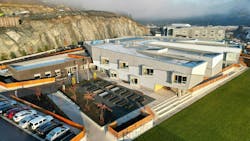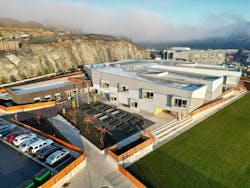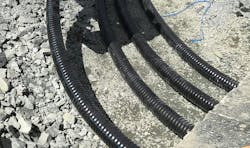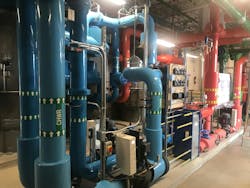High Marks for School Efficiency
As more families moved to the western communities of Greater Victoria, the local Sooke School District realized they needed to build two additional schools to accommodate the more than 1200 elementary- and middle-school students who would be attending. The schools needed to be seamlessly integrated into the existing landscape as well as be Earth-friendly in every way (see Figure 1). This required optimizing energy efficiency by targeting LEED v4 Gold certification. Attaining Gold certification means that a building has incorporated a sustainable design that carries through future operations. Such buildings are singled out as using innovative approaches for how they conserve energy, reduce water use, and enhance indoor air quality.
The Sooke Schools achieved their Gold certification through incorporating elements such as photovoltaic panels on the roof, strategically positioned and designed windows, and a geothermally-boosted HVAC system that runs heating and cooling water through the ground to extract or reject heat as needed for added efficiency. The planners also decided upon a district heating model, in which a central plant collects and distributes energy between the two schools for flexible heating and cooling. Rather than having two mechanical rooms, water is conditioned at a single heating/cooling plant to easily accommodate different energy cycles between the schools. If one building requires less heat, the excess heat can be moved to the other building. Heating and cooling can be produced simultaneously by a water source heat pump, with additional heating provided by electric boilers as needed. They also chose to make the operation available for educational purposes (see Sidebar: Supporting District Heating Education and Awareness).
Design Considerations
According to Michael Hladky, principal of engineering firm SMcN Consulting Inc., the key in these distribution piping or energy transfer piping applications is to keep the heating or cooling energy from escaping while it travels underground to the schools. To meet this challenge, the team specified REHAU INSULPEX pre-insulated PEXa pipe as the basis of their design. INSULPEX pipe was specifically designed to efficiently transfer hot or chilled fluid through buried pipelines to minimize energy loss. The REHAU O2 barrier pipe also incorporates a co-extruded oxygen diffusion layer that prevents corrosion of any cast iron components within the heating system in compliance with DIN 4726.
“We were using a very low-temperature/high-efficiency heating water system with water at only 46°C (115°F), so we couldn’t afford to lose much heat in the trip through the pipe from the heating plant to the buildings. With INSULPEX, the heat loss numbers were within tolerance and the pipe met all aspects of the demanding design criteria very well,” Hladky says.
Transferring energy from the central plant to each school is 125 mm INSULPEX pipe. The middle school uses 671 m (2,200 ft) of INSULPEX, while the elementary school uses 183 m (600 ft). In both cases, the flexible pipe is supplied in coil lengths of 40 m (130 ft) or greater and consists of PEXa O2 barrier pipe surrounded by foam insulation and a durable corrugated PE outer jacket (see Figure 2).
Both Hladky and McLaren note that, although they had used REHAU products for indoor radiant heating applications, this was their first experience with the products in outdoor underground piping. They agreed that it was uncommon, in that climate, to bury building heating piping underground. Hladky said, “Plastic piping like REHAU’s was the clear choice for long-term durability — corrosion would be a concern for metal piping — plus INSULPEX comes pre-insulated right from the factory, so we were confident that the installation would be even, consistent, and gap-free throughout.”
Choosing PEXa piping that is already pre-insulated further streamlined the installation process. Metal piping must be manually insulated on the jobsite, which becomes costly, labor-intensive, and can lead to performance issues. The flexibility of PEXa supports faster installation because installers can easily navigate bends or obstacles without the need for extra fittings or couplings, minimizing potential leak points. Bell said, “We put in thousands of feet of pipe and had no leaks at all.”
Installers were able to achieve quick and secure connections using the user-friendly RAUTOOL hydraulic tool kit. Gord McLaren, Division manager of mechanical contractors at Professional Mechanical Ltd, explains, “Larger bore pipes are generally more challenging to work with, but the RAUTOOL does the work for you.” Project installer, Joe Bell, added, “You can’t put the pipe and fittings together wrong. The tool won’t let you misposition anything.”
McLaren was also impressed with the hands-on assistance he and his team received from REHAU field reps. “It was great to have an expert available to bounce off ideas when it came to different ways to lay the pipe, work the joints, connect spools, terminate the pipe, and other aspects. It definitely gave us an edge in ensuring we did an optimal job.”
REHAU also provides a lot of technical information online that helps their customers calculate relative flow rates, pressure drops, pump sizes, heat loss, and other aspects of typical projects. Having this information readily available allows engineers to efficiently calculate design parameters and determine product compatibility with their project in mind.
The Sooke School District project incorporated a unique design that will not only provide lower overall HVAC costs over time, but allowed for quick and easy installation, and facilitated the requirements needed to achieve LEED v4 Gold certification. The REHAU products and installation tools were important for the project, offering the right materials and tools, while the company itself provided real time services when needed.
According to Michael Hladky, principal of engineering firm SMcN Consulting Inc., the central plant for the two new Sooke District schools was designed to provide educational value to others. The project team implemented the central plant as a learning hub for upcoming engineers and trades workers, including features such as color-coded pipes and a TV dashboard that displays plant data, energy consumption, and GHG (greenhouse gas) savings (see Figure 3). While central plants are often concealed, this project prioritized visibility with windows at the front of the building, so industry professionals and the public could learn about the inner workings of district heating applications.
As a result of the collaboration among SMcN Consulting, Professional Mechanical, and REHAU, the schools now have a high-performing district heating application that facilitates a high-quality learning and working experience for students and teachers. The schools are contributing to a more sustainable future in their community, while also supporting the development of the next generation of engineers and trades workers.



